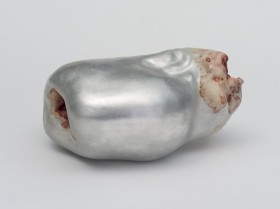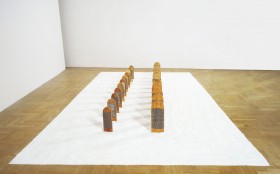Pyramid of Animals
- type of object: sculpture
- date: 1993
- material/technique: stuffed animals, video
- dimensions: 220 x 190 x 120 cm, 47'
- inventory No.: RZ-46
- image licensed under: CC BY-NC-ND 3.0
Katarzyna Kozyra is one of the most important representatives of the critical art movement developing in Poland after 1989. In her work, she challenges social taboos and explores issues related to the body, ageing, mortality and vulnerability to disease. The Pyramid of Animals is her graduation piece, inspired by the Brothers Grimm fairy tale Town Musicians of Bremen. The installation features four taxidermised animals stacked on top of each other. The artist herself chose a horse and a rooster to be put to sleep. The sculpture is accompanied by a film shot in a slaughterhouse.
The piece unleashed a fierce wave of media criticism, initiated by letters of protest from the board of the Association of Polish Artists and Designers (ZPAP) to the rector of the Academy of Fine Arts and the Ministry of Culture and Art. Kozyra was attacked without any attempt to understand the meaning of her work. She was accused of violating moral principles because the death of animals was used to create a work of art rather than for practical purposes. In a letter to the editor of Gazeta Wyborcza, Kozyra explained that her composition was ‘about death in general and the death of these four particular animals’. ‘I didn’t do it “for thrills” or because of a lack of technical skill. I did it out of an inner need to ask the question: do we still feel the presence of death when we eat pork chops, use cosmetics or other products derived from animals . . .?’ The Pyramid of Animals speaks to the hypocrisy of a society that considers the killing of animals to be civilised and justified when it satisfies practical needs and is carried out industrially, out of sight of the consumer.
Ewa Skolimowska
video accompanying the sculpture
Audio description: No sound
Artist's statement:
A very specific situation developed while I was working on this piece, a situation that caused myself and those somehow included in the process of creation to react in many different ways.
The starting point was an animal pyramid, which can be found in the fairy tale of the Brothers Grimm. The actual content of the tale was not important. What drew my interest was the structure itself – the animal pyramid and the visual and conceptual spheres that are somehow linked to it. As opposed to, for example, a seven-headed Dragon (which appears in other fairy tales), what was intriguing about this sculpture was that it could be made using ready-made materials, i.e. animals. The idea of this monument to animals – this pyramid, carries in itself clarity and simplicity, and at the same time a rich and multi-layered symbolism (belief, culture, religion).
The material, which I used, was a given, that is the animals: a horse, a dog, a cat, and a rooster. Then the problem arose – where could I get the material for the monument” I began my preparations from the basics, that is I chose the live animals. They were not selected from museum collections of trophies, but were found and selected according to a set of criteria. Hence there was conscious selection which was the result of the prepared composition. What mattered was what kind of statement they would make, would they be representing themselves or would they be symbols of these animals. If the assumption of the sculpture was just to get across some sort of symbolic message, it could have been made of clay or other materials used in sculpting, or finally out of stuffed museum exhibits.
The concept was different, the material for the sculpture existed and these were concrete animals selected by myself. The later stage, that is the death of the animals and their stuffing was a very risky step, but at the same time intriguing. I was balancing on the edge of accepted ethical norms, while at the same time I was touching that difficult thing called the death of a living creature.
All of these animals were basically destined to die, however, using them for the sculpture generated ethical problems. And yet animals are murdered everyday and used for everyday purposes, or for consumption. My personal participation in the act of death and using their carcasses to realize an idea changes the point of view, it has evoked and continues to evoke various reactions. The making of piece ended up being a peculiar situation.
The question arose: Did the process of creation become more important than the piece I was trying to create” The answer to this question and the perception of the entire process of creation of this work were far from singular in their interpretation.
When the horse was put to sleep and skinned a film was shot of this event. This is a macabre document showing the fresh corpse of the animal. In the first shots you can see the still trembling flesh of the horse and then you can see only the fragments of the carcass, which looks quite normal and people are used to seeing that – all you have to do is go to the meat shop. And yet the participation of other people at this stage of creation evoked reactions of shock, lack of understanding, and even rejection. The same was true in the case of the other animals. I began to question whether to be consistent in the process of realizing this piece, whether the killing of the horse was to be followed by the killing of other animals, for the process to be consistent. The final piece – the diploma work – is nevertheless aesthetic, worthy of being looked at, and contains no gore. What you have here is the paradox between the final effect and the process of its creation, which for me was more important. The idea of a monument to animals, a pyramid, was realized thanks to cooperation with Mr. J. Linkowski, whose professionalism in stuffing animals can be called an art. This piece was made for my diploma and was subject to evaluation, but can this work be viewed only as a sculpture, or can the process of its creation and the related reactions also be evaluated.
text of a publication accompanying the display of “The Pyramid of Animals”, Academy of Fine Arts, Warsaw 4 June 1993
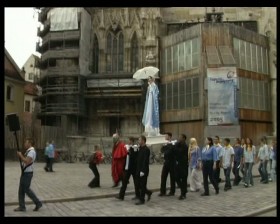 Madonna from Regensburg2005
Madonna from Regensburg2005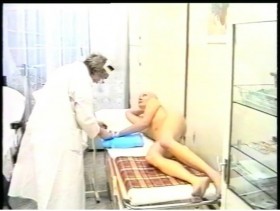 Olimpia1996
Olimpia1996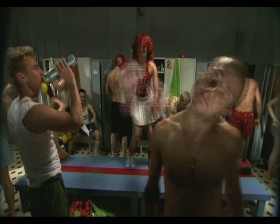 Cheerleader2006
Cheerleader2006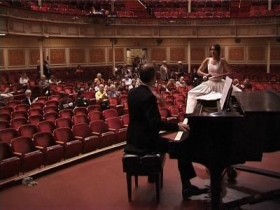 A Quarter of an Hour2004
A Quarter of an Hour2004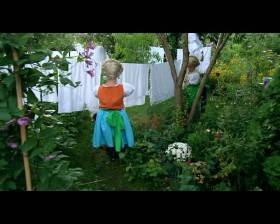 Summer Tale2008
Summer Tale2008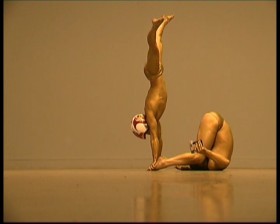 Lords of the dance2002
Lords of the dance2002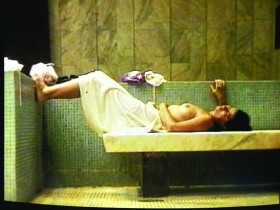 The Bathhouse1997
The Bathhouse1997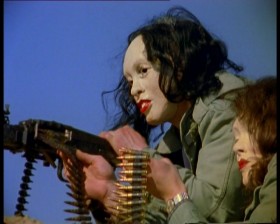 Punishment and Crime2002
Punishment and Crime2002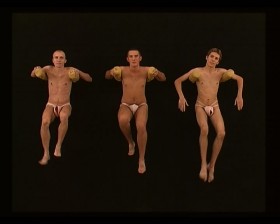 Dance Lesson2001
Dance Lesson2001 It's better to know nothing, from series Eight2000
It's better to know nothing, from series Eight2000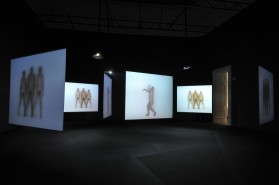 The Rite of Spring1999
The Rite of Spring1999- Blood Ties1995
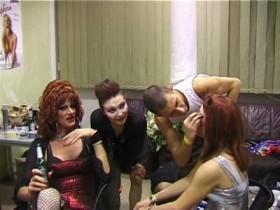 Non so piu2004
Non so piu2004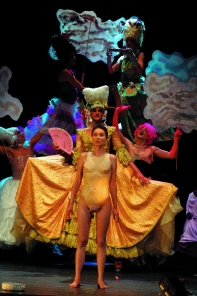 The Castrate / Il Castrato2006
The Castrate / Il Castrato2006- The Castrate / Il Castrato2006
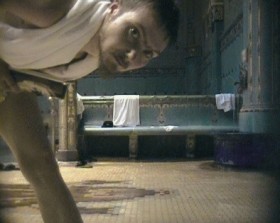 Men's Bathhouse1999
Men's Bathhouse1999 In Art Dreams Come True2006
In Art Dreams Come True2006 Faces2005
Faces2005 1991
1991- 2011
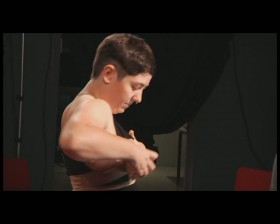 Casting. Tel Aviv2011
Casting. Tel Aviv2011 Beauty-Preview with Gloria Viagra2005
Beauty-Preview with Gloria Viagra2005 Stairs from the series Boys2001
Stairs from the series Boys2001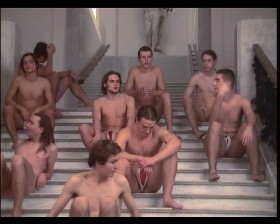 Spears from the series Boys2001
Spears from the series Boys2001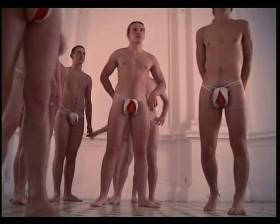 Ragazzi from the series Boys 2001
Ragazzi from the series Boys 2001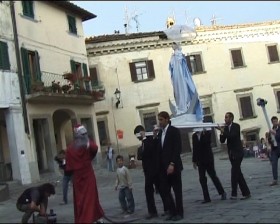 Madonna from Pelago2005
Madonna from Pelago2005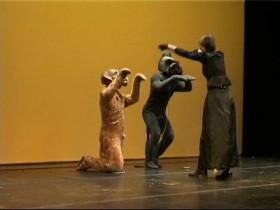 Teatro di cani. Lou Salome a Roma2005
Teatro di cani. Lou Salome a Roma2005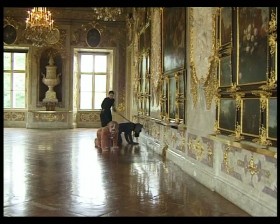 Appearance as Lou Salome2005
Appearance as Lou Salome2005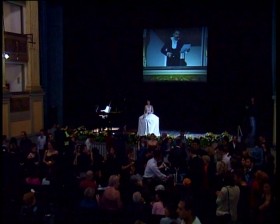 The Nightmare2004
The Nightmare2004 Facade Concert2005
Facade Concert2005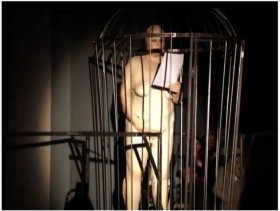 Diva: Reincarnation2005
Diva: Reincarnation2005 Tribute to Gloria Viagra: Birthday party2005
Tribute to Gloria Viagra: Birthday party2005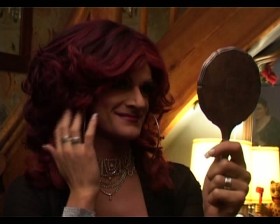 The Winter's Tale2005
The Winter's Tale2005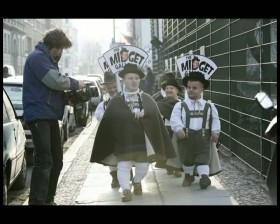 The Midget Gallery2006
The Midget Gallery2006


